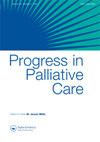End-of-life care at home as a therapeutic landscape within a compassionate communities approach
IF 0.8
Q4 PUBLIC, ENVIRONMENTAL & OCCUPATIONAL HEALTH
引用次数: 0
Abstract
This article argues that a compassionate communities approach towards the end of life is a type of therapeutic landscape with particular characteristics. The emergence of public health approaches within palliative and end-of-life care has gained momentum internationally, with the concept of compassionate communities as one of its components. This qualitative case study explored the lived experiences of compassionate communities towards the end of life from the perspective of key actors at three different research sites providing palliative care, two of which were hospice settings and one a community organisation. The data collection methods included semi-structured interviews, focus groups, and contact diaries of people living towards the end of life (primary participants), their family members, friends, as well as volunteer befrienders and health professionals. Although there were differences in the compassionate communities approach across all three sites this study identified shared characteristics. First, home as the preferred place of care with physical, social, and psychological symbolic meanings; second, formal and informal care interfacing within and across inner and outer circles of care; third, the essential role of volunteer befrienders within the inner circle of care which strengthened the interface between the formal and informal care. The relational aspect between formal and informal care was considered to be significantly important. The characteristics of compassionate communities approaches within a home-based setting, meet the criteria for a type of therapeutic landscape, a place of maintaining well-being towards the end of life.在富有同情心的社区方法中,居家临终关怀作为一种治疗景观
本文认为,一个富有同情心的社区接近生命的终结是一种具有特殊特征的治疗景观。在国际上,缓和和临终关怀中出现了公共卫生方法,富有同情心的社区概念是其组成部分之一。这个定性案例研究从三个不同的研究地点提供姑息治疗的关键角色的角度探讨了富有同情心的社区在生命结束时的生活经历,其中两个是临终关怀设置,一个是社区组织。数据收集方法包括半结构化访谈、焦点小组和接近生命终点的人(主要参与者)、他们的家庭成员、朋友以及志愿辅导员和卫生专业人员的联系日记。尽管这三个地方的富有同情心的社区方法存在差异,但这项研究发现了共同的特征。首先,家作为照顾的首选场所,具有身体、社会和心理上的象征意义;第二,正式和非正式护理在内部和外部护理圈之间相互作用;第三,志愿帮助者在护理内圈中的重要作用,加强了正式和非正式护理之间的联系。正式和非正式护理之间的关系被认为是非常重要的。在以家庭为基础的环境中,富有同情心的社区方法的特点符合一种治疗景观的标准,这是一个在生命结束时保持幸福的地方。
本文章由计算机程序翻译,如有差异,请以英文原文为准。
求助全文
约1分钟内获得全文
求助全文
来源期刊

PROGRESS IN PALLIATIVE CARE
PUBLIC, ENVIRONMENTAL & OCCUPATIONAL HEALTH-
CiteScore
2.60
自引率
11.80%
发文量
24
期刊介绍:
Progress in Palliative Care is a peer reviewed, multidisciplinary journal with an international perspective. It provides a central point of reference for all members of the palliative care community: medical consultants, nurses, hospital support teams, home care teams, hospice directors and administrators, pain centre staff, social workers, chaplains, counsellors, information staff, paramedical staff and self-help groups. The emphasis of the journal is on the rapid exchange of information amongst those working in palliative care. Progress in Palliative Care embraces all aspects of the management of the problems of end-stage disease.
 求助内容:
求助内容: 应助结果提醒方式:
应助结果提醒方式:


